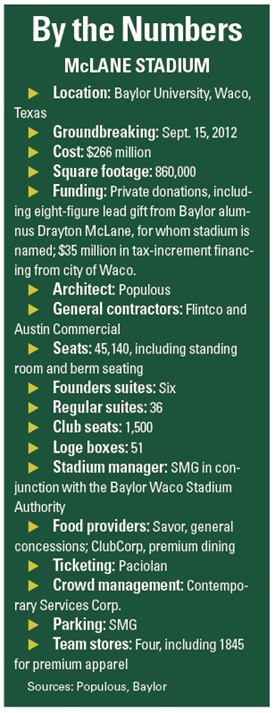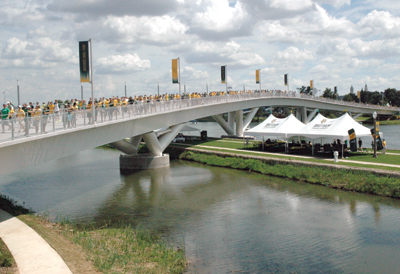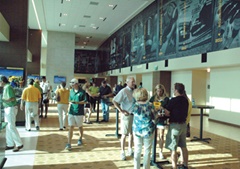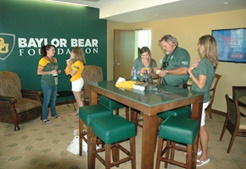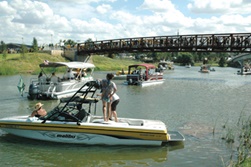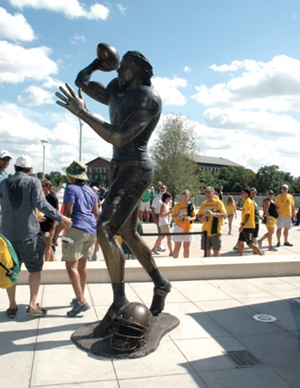A few hours before Baylor’s first football game at McLane Stadium, school tradition got a novel addition as the team walked across a footbridge to its gleaming new facility.
Below the bridge on the Brazos River, the waterway running through Waco and past the front door for the school’s $266 million venue, a small armada of pontoons and bass boats converged to salute the players.
 |
McClane Stadium sits just across the Brazos River from the Baylor University campus.
All photos by: DON MURET / STAFF
|
They honked horns, creating a wall of sound as the team walked through the traditional Baylor Line, a large group of freshmen wearing matching gold T-shirts, all of them high-fiving the players.
The “March of the Bears” routine started under coach Art Briles a few years ago at landlocked Floyd Casey Stadium, the school’s old football venue a few miles from campus. Now, by virtue of the new stadium site, fans partying by boat can also toast the
{podcast}
SBJ Podcast:
Facility writer Don Muret and Executive Editor Abraham Madkour talk about trends in the sports facility industry and the current building boom.
Bears as they enter the building.
Regardless of their tailgate spot of choice, Baylor fans can all toast those who offered the blueprint for making the critical decision to build on the Brazos.
The school and the city grabbed hold of the developers’ vision to revitalize the waterfront; Waco’s downtown district, less than a mile away; and a boggy piece of the Baylor campus, and the new stadium sits front and center. It also brings football back to campus for the first time in 79 years and gives the school and the city a broader development strategy over the next decade they might not otherwise have had, said Earl Santee, Populous principal-in-charge of the project.
The stadium replaces what was basically swampland that held low-income housing and an old hotel fraught with structural issues, said Santee, who originally came up with the idea to build by the Brazos.
As the story goes, Santee had been searching for sites at the request of Drayton McLane, the former owner of the Houston Astros, for whom Baylor’s stadium was named after his eight-figure gift jump-started the development. Santee had a photograph made of the entire campus, and in meetings with Baylor officials, he placed a model of a typical football stadium on the east side of campus. Then, Santee moved the model along Interstate 35 by the river “and there was no doubt that was where it needed to be. It was that simple of a process,” he said.
“In fact, the room went silent for about a half-hour after we did that,” Santee said. “For us, we started with the fact that by moving it over here [by the river], it had to be more than just a football stadium. … It was one of those moments you have with a client where it all just clicked.”
The city kicked in $35 million in tax-increment financing to help fund construction in exchange for becoming the school’s partner in the Baylor Waco Stadium Authority, the facility’s governing body providing oversight of non-Baylor events in tandem with SMG, the stadium’s management firm.
For college football stadiums, the business model is somewhat unusual, and SMG officials will look for other opportunities to partner with schools and governing bodies to run those facilities, said Doug Thornton, SMG’s executive vice president of stadiums and arenas.
Putting the facility on the waterfront added a $20 million premium to the project, but it was well worth it considering the potential for future development, McCaw said.
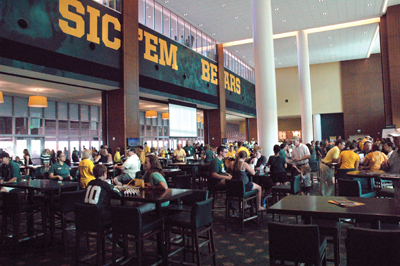 |
The Baylor Club is reserved for loge and club seat ticket holders.
|
As the stadium took shape over the past two years, it became a catalyst for further development in a city searching for a strong anchor to push other projects forward, said Sherri Privitera, Populous’ project manager. One example is new student housing tied to a private developer that bought the low-income housing and tore it down, Privitera said.
Baylor Athletic Director Ian McCaw said other developers are now buying up property and older homes with plans to build restaurants and retail near the stadium on the other side of Interstate 35, dividing the nation’s midsection. Every year, more than 40 million vehicles travel that portion of the central Texas corridor. Building next to I-35 was also key, project officials said. The first thing motorists see driving southbound on the highway through Waco is the sign attached to the top of the facility spelling out McLane Stadium. It gives the school prime brand exposure, McCaw said.
“This project has really galvanized Baylor and the city of Waco unlike we’ve ever seen before,” he said. “Obviously, it gives our football program a big lift and it’s a great landmark for the university, but this has really been a great economic engine for central Texas.”
Making it all happen involved building a pedestrian bridge over the river — separate from the smaller one the players use to get to the stadium. The larger bridge measures 775 feet long and 35 feet wide, a key piece of the project connecting the building to the rest of campus.
On game days, 30,000 fans, filling two-thirds of the 45,000-seat stadium, use that pathway to access the stadium. The bridge, named for donors Sheila and Walter Umphrey, is already a hit with fans, who take photos with the stadium and river in the background.
McLane Stadium itself has a brick exterior and tinted green glass that blends in well with the Baylor’s green-and-gold color scheme. White structural columns supporting the stadium outside match the school’s Georgian-style architecture.
A shade canopy, a combination of steel and fabric, rings the top of the stadium to help fans withstand the oppressive Texas heat that can stretch into October, said Brian Nicholson, Baylor’s associate vice president of facilities, planning and construction. In a design twist, 38 stadium walls have small vents to provide air flow inside the building.
The main concourse, a spacious 46 feet at its widest point, is branded with images of past Baylor greats such as Mike Singletary and Walter Abercrombie and logos of Texas Farm Bureau Insurance, sponsor of the main level and the stadium’s ticket office.
Local health care provider Baylor Scott & White sponsors Gate A and supermarket chain H-E-B serves as the team’s official red zone sponsor.
Minnesota’s TCF Bank Stadium, another Populous design, and TCU’s renovated Amon G.
Carter Stadium, an HKS project, were two college facilities Baylor looked to for developing McLane Stadium.
All the suites, club seats and loge boxes are on the stadium’s west side. Baylor’s 51 outdoor loge boxes, spread across two levels, were modeled after the Gophers’ facility and improved upon with granite counter space directly behind those groups of four to 12 seats.
The six Founders Suites, a concept adapted from TCU, sit at the 50-yard line and sold for at least $10 million tied to 20-year terms. On average they carry 24 indoor seats, and most of them will be paid off within five years, McCaw said.
Each founder has a personal parking spot in a private garage underneath the stadium. Attached to the garage is a waiting room for personal drivers. Populous is designing a similar space as part of Texas A&M’s $450 million renovation of Kyle Field, Santee said.
The 36 holders of regular suites on the fourth level pay $1 million to $3 million apiece, depending on location and terms, which run five to 10 years. They get their own lounge as well, the 9,000-square-foot Letterwinners Club. One club wall is adorned with graphics from past Baylor bowl games.
The larger Baylor Club on the second level is reserved for the loges and 1,500 club seat holders. The 17,000-square-foot restaurant is open year-round, and ClubCorp, the company running all premium food service, has exceeded booking projections for non-game-day functions, stadium officials said.
Both the upper and lower concourse have open views to the field modeled after newer MLB parks. The 3,600 freshmen who make up the Baylor Line on the field before games now run underneath the stadium and through the player tunnel to get to their general admission seats, more organized than the haphazard formation at Floyd Casey Stadium.
The grass berm beneath the 4,770-square-foot video board in the south end fits 2,000 general-admission patrons. Those tickets cost $30 a game.
All told, Baylor has sold every ticket for the stadium’s inaugural season and its season-ticket base has jumped to 28,000. Eleven years ago, when McCaw first arrived on campus, there were just 8,000 season-ticket holders attending games at the old facility.
The school held back 8,000 seats a game for students who pay an annual fee to attend as many sports events as they want, including football. Students blew through that online inventory in 50 minutes the day those tickets went on sale, McCaw said.
At the same time, McCaw knows fewer students nationally are attending college football games. To keep them engaged at Baylor, the school teamed with tech firm YinzCam to develop Baylor InGame, a new mobile application that includes multiple camera angles for live action and replays.
For the first game, Aug. 31 against SMU, the application peaked at more than 20,000 views, said Pattie Orr, Baylor’s vice president for information technology and dean of university libraries. (The heaviest usage corresponded to major plays, and there were plenty in Baylor’s 45-0 victory.)
It’s all part of the $2 million the school invested in wireless infrastructure through vendors Extreme Networks and AT&T. Baylor used Extreme to build its Wi-Fi network after seeing Extreme’s system at Gillette Stadium, home of the New England Patriots. AT&T supplied the distributed antenna system. McLane Stadium is thought to be the first new college football venue to include those features from the ground up, Santee said.



